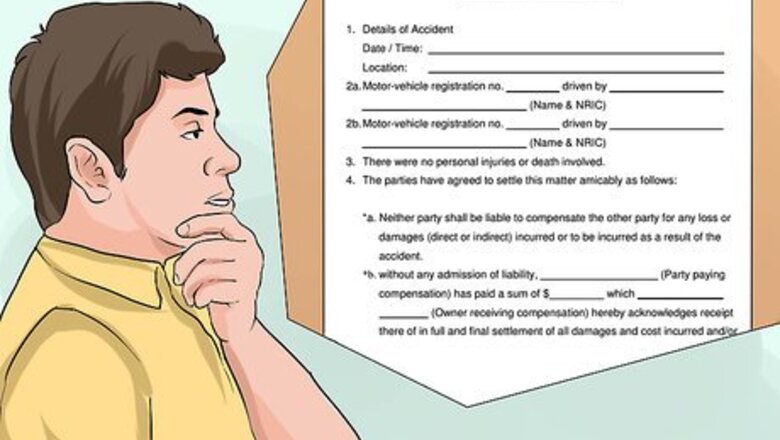
views
Contemplating Your Settlement Agreement
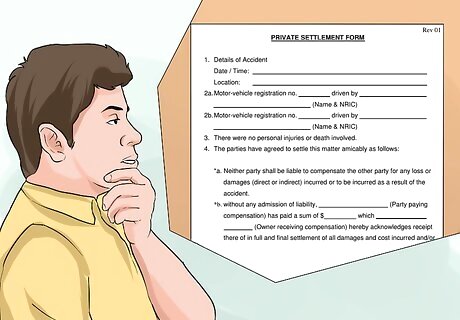
Decide whether you have the need for a settlement agreement. A settlement agreement is a legally enforceable contract. They can be used in a variety of situations where two parties are in dispute about something and they wish to compromise on how that dispute will be resolved. A settlement agreement will act as a "release," which means that in exchange for some act (often the payment of money), one person will give up their legal claim against another person. For example, if your garage is damaged when your neighbor backs into it with their car, you might agree to settle this dispute and release your neighbor from any legal liability if he or she agrees to pay for the repairs to your garage. Some of the most common situations in which a settlement agreement is utilized include: disputes over damaged property; employment disputes between employers and employees; marriage disputes; and medical malpractice disputes.

Determine whether you have the ability to enter into a settlement agreement. You will need to decide if you have the legal capacity to enter into a valid contract, which involves knowing what you are getting yourself into by entering into the agreement. A settlement agreement should be in writing. Also, you will want to know what is needed to create a legally binding contract. Those requirements include: An offer. This is what one party proposes to do, pay, etc. Acceptance. This is the willingness to be bound by the terms of the offer. Valid consideration. This is something of value that the promisor receives from the promisee in return for the promise. It can be tangible or any type of benefit. For example, if you offer to sell your car to your brother for $4000 and he accepts, the $4000 is the consideration. To be valid, consideration must be reasonable and agreed on by both parties without coercion. Mutual assent. Both parties must accept the offer without being forced to do so by coercion or any other means. For example, if you agreed to give a robber all of your money so that he does not shoot you, there is no mutual assent even though there is an offer and acceptance. A legal purpose. A settlement agreement must also not be "unconscionable." This means that it cannot be illegal, fraudulent, or criminal. For example, you could not agree to settle a lawsuit in exchange for six pounds of cocaine, because the sale of cocaine is illegal in the United States.

Ensure the terms and provisions you want to put in your contract comply with your state's laws. If you are unable to determine whether your contractual provisions will comply with state law, you may want to consider hiring or consulting an attorney. In general, any contract lawyer or lawyer practicing in the field your dispute arises in (e.g., property law, tort law, family law) will be able to help you determine if your settlement agreement is likely to be valid.
Negotiating the Settlement Agreement

Agree on a statement of the dispute. Both parties are likely to have a differing view of the dispute. Before writing your settlement agreement, you must come to an agreement of the factual terms of the dispute. A mediator may be helpful in determining this.

Negotiate consideration. The consideration is what one party is going to receive in return for giving up any possible legal remedy. You will also want to determine how the compensation will be turned over (i.e., all at once or over time). For example, payment arrangements and logistics should be hammered out before you write the settlement agreement.

Determine whether one party will have to admit liability. This is likely to be a point of contention in some settlement agreements. Some parties will be willing to settle only if they do not have to admit to liability or wrongdoing. This is very common in corporate settlements. For example, if you are agreeing to settle with a corporation whose hair dye turned your hair green and made it fall out, the corporation could agree to the settlement agreement as long as the settlement is not construed as admission of fault or wrongdoing on their part.

Negotiate any conditions. Sometimes, a conditional settlement agreement may be desirable. For example, this is the case where an action must be performed in order to resolve the issue, but that action will take time to complete. It is not usually desirable in situations where something may not be completed by a certain date, such as keeping a trade secret confidential. In this case, you should negotiate an unconditional settlement agreement, which takes effect after a certain number of days.

Negotiate the scope of the release. You must negotiate the scope of the release in the agreement to determine which claims will be resolved, and whether any future claims are also resolved by this settlement agreement. You can negotiate a provision stating that the settlement agreement applies to all claims arising out of the dispute, whether they are current or not yet realized, or the settlement may resolve just one aspect of a suit or a single claim. This will depend on your needs.
Writing the Settlement Agreement
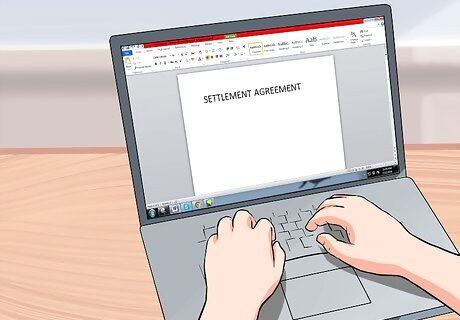
Title the document. Begin your settlement agreement by titling the document in a way that informs the reader about what the agreement is. Depending on the case, it may also require a caption or style of the case to be added. For example, if it is part of ongoing litigation, it may need to include the names or identifiers of all plaintiffs, and this information could change as the case develops.
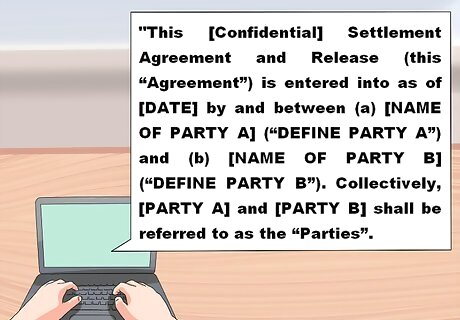
Identify the parties. You should write a paragraph that introduces the parties to the agreement (who is involved in it) and defines their roles. You should include names and addresses, as well as a statement that the parties named have the capacity and authority to enter the agreement. The statement may also state that the parties named have the capacity to bind a company or entity, if this applies. For example, if your settlement agreement is with a small business, the small business owner could agree to serve as the binder for his company. For example, a common introductory paragraph looks like this: "This [Confidential] Settlement Agreement and Release (this “Agreement”) is entered into as of [DATE] by and between (a) [NAME OF PARTY A] (“DEFINE PARTY A”) and (b) [NAME OF PARTY B] (“DEFINE PARTY B”). Collectively, [PARTY A] and [PARTY B] shall be referred to as the “Parties”." When you define the parties, you will describe one party as the one being released from legal liability, and you will describe the other party as the one granting the release.

Provide a description of the dispute. In this section you will need to describe the "who," "what," "when," "where," and "how" of the dispute. It is important to do this so both parties are in agreement about what specific act is being discussed in the agreement and what is being settled. Without this provision, a court will have a tough time upholding and enforcing your settlement agreement in the event it is breached or you have to get it approved. If you are settling a medical malpractice dispute, you may write a scenario that explains: who the patient was and who the doctor or doctors were; what happened that caused the dispute, (e.g., the doctor left a sponge in the patient's abdomen after the surgery); when the dispute occurred, (e.g., on March 5, 2014 at approximately 12:15 p.m. while the patient was in surgery); where the dispute occurred (e.g., at the doctor's office, located at a certain address); and how the dispute occurred (e.g., the doctor was not paying attention and forgot about the sponge and the patient found out when they started having pains in their side). Be as detailed as possible and include any information you may think is relevant to the agreement you are creating.
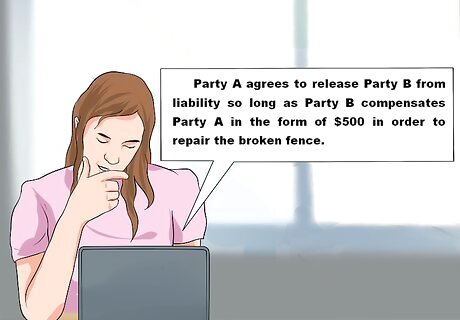
Include a statement about what one party is going to receive in return for the release of the other party from any and all legal liability. This section will include the required consideration, which is necessary to spell out in order to have a valid contract. The type of payments that can be contracted for are wide-ranging and will depend on what the dispute was that led to the settlement agreement you are creating. Compensation could be in the form of money, repairs, replacements, or even promises. Compensation cannot be anything illegal, fraudulent, or criminal. If you are entering into a settlement agreement as a result of property damage, your provision may state: "Party A agrees to release Party B from liability so long as Party B compensates Party A in the form of $500 in order to repair the broken fence." Also, instead of including a dollar amount, the provision may state that Party B will be required to repair the broken fence his or herself in order to be released from liability. If you are executing a settlement agreement as a result of something like trespassing, you may include a provision stating Party A agrees to release Party B from liability so long as Party B never trespasses again. You may then include a sentence stating that if Party B does trespass again, the settlement agreement will be null and void and Party A will be free to pursue legal action. When you are drafting this provision, be sure you are confident in the consideration you are receiving or giving up. Settlements are legally binding contracts and you will likely be stuck with the compensation you agreed to, even if you find out later it is grossly inadequate or extremely over the top. For example, if you agree to compensate someone $500 for the damage you caused to their vehicle, and they later find out the actual cost of repair was $5,000, they will likely be stuck with the $500 you provided and they will not be able to collect more.
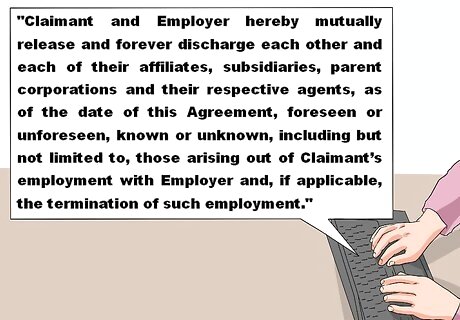
Include a statement regarding the scope of the claims to be settled. During negotiations, you should have determined with the other party whether the settlement agreement will resolve all claims, including unknown and future claims, or whether it will cover only a certain claim. In general, it is advisable to resolve all claims, including unknown and future claims, with your settlement agreement. You should look to include a provision that looks something like this: "Claimant and Employer hereby mutually release and forever discharge each other and each of their affiliates, subsidiaries, parent corporations and their respective agents, present and former directors, officers, executives, employees, predecessors and/or successors in interest, attorneys, heirs and assigns, from any and all matters, claims, complaints, charges, demands, damages, causes of action, debts, liabilities, controversies, judgments and suits of every kind and nature whatsoever, arising out of the same subject matter or occurrence as this claim/cause of action, as of the date of this Agreement, foreseen or unforeseen, known or unknown, including but not limited to, those arising out of Claimant’s employment with Employer and, if applicable, the termination of such employment." This specific clause is tailored to an employment dispute, but you can change the wording and the parties in order to make it fit your needs. Not all settlements will resolve any and all claims arising from the dispute. Make sure to negotiate a clear statement of scope.
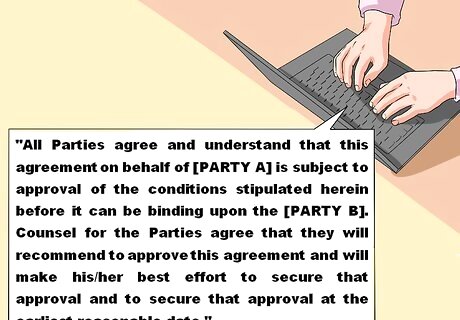
State the conditions clearly. Sometimes, a conditional settlement agreement may be desirable. For example, this is the case where an action must be performed in order to resolve the issue, but that action will take time to complete. It is not usually desirable in situations where something may not be completed by a certain date, such as keeping a trade secret confidential. In this case, you should negotiate an unconditional settlement agreement, which takes effect after a certain number of days. For example, if a contractor you hired ruined your attic through faulty building, a settlement agreement could negotiate your waiving your right to sue conditional on the contractor replacing the attic at no cost and passing a building inspection within one month. If the condition is not met, the settlement agreement is nullified. You might want to include language such as the following: "All Parties agree and understand that this agreement on behalf of [PARTY A] is subject to approval of the conditions stipulated herein before it can be binding upon the [PARTY B]. Counsel for the Parties agree that they will recommend to approve this agreement and will make his/her best effort to secure that approval and to secure that approval at the earliest reasonable date." Then you would spell out the exact conditions that will satisfy the agreement.
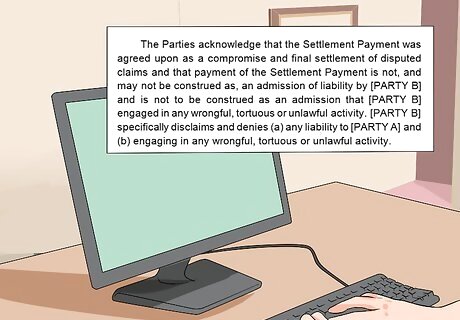
Spell out whether the release will include any admissions of fault or liability. Oftentimes, when parties are agreeing to settle a dispute through a mutual agreement as opposed to going through the judicial process, the party providing the settlement payment will not want to admit any liability or fault. If you have previously negotiated this, provide a clause, like the one below, that allows the party in the wrong to compensate the other party without having to admit any wrongdoing. If you plan on including a provision agreeing that the settlement will not include any admissions of fault or liability, you may want to use the following language: "The Parties acknowledge that the Settlement Payment was agreed upon as a compromise and final settlement of disputed claims and that payment of the Settlement Payment is not, and may not be construed as, an admission of liability by [PARTY B] and is not to be construed as an admission that [PARTY B] engaged in any wrongful, tortious or unlawful activity. [PARTY B] specifically disclaims and denies (a) any liability to [PARTY A] and (b) engaging in any wrongful, tortious or unlawful activity."
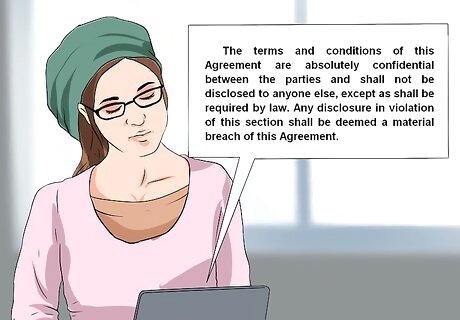
State whether the settlement agreement will be confidential. Making your settlement agreement confidential ensures that neither party can discuss or reveal any of the terms of the settlement to the world. This type of provision comes up most in business settlements where one company is often involved in litigation and settlement, and does not want other potential litigants to know the usual terms of their agreements. It may also come up in medical settlements where a doctor wants to restrict the patient's ability to reveal what happened and how much the doctor paid out. If you wish to include a confidentiality provision, it may look like this: "The terms and conditions of this Agreement are absolutely confidential between the parties and shall not be disclosed to anyone else, except as shall be required by law. Any disclosure in violation of this section shall be deemed a material breach of this Agreement."
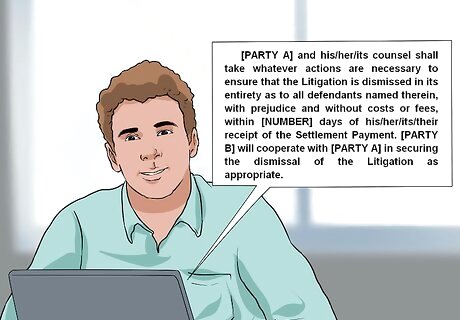
Include a provision about the dismissal of any ongoing litigation. If you are in the middle of litigation when you decide to settle and create a settlement agreement, be sure you include a provision ensuring that both parties will dismiss the litigation and not move forward with it. If you are in this situation, consider using this language: "[PARTY A] and his/her/its counsel shall take whatever actions are necessary to ensure that the Litigation is dismissed in its entirety as to all defendants named therein, with prejudice and without costs or fees, within [NUMBER] days of his/her/its/their receipt of the Settlement Payment. [PARTY B] will cooperate with [PARTY A] in securing the dismissal of the Litigation as appropriate." It is highly advisable to have your settlement agreement approved by the court. This constitutes a court order, which is far easier to enforce than a simple contract. Especially if you are not certain whether the other party will abide by the terms of your agreement, you should present the settlement agreement to the court for approval.
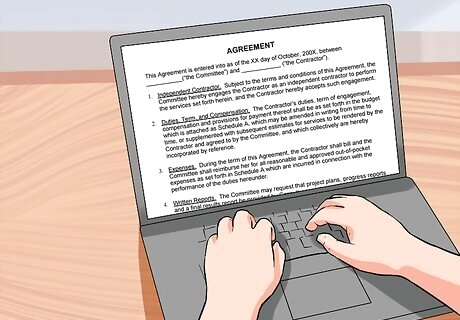
Ensure the settlement agreement includes your basic boilerplate provisions. Towards the end of your contract you will include any standard provisions that are usually found in contracts. Most of these provisions you can simply take from a form contract you find, but make sure you read over them and ensure they say what you want them to. Some of these provisions may include: Severability provisions; Modification provisions; Indemnification provisions; Choice of law provisions; and Entire agreement provisions.
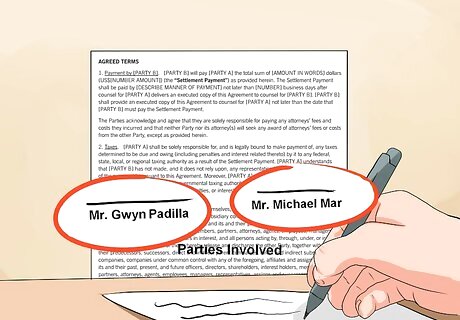
Provide an area for signatures. At the very end of the contract you will make space for all parties to sign the contract. This area should have spaces for your signatures and dates.
Executing the Settlement Agreement

Offer your contract to the other party. Once you have written your settlement agreement you will offer it to the other party. Assuming that your negotiation process went smoothly, both parties should be satisfied. However, the other party has several options once presented with the agreement: The other party may accept the offer in full. In this instance, you will then sign the contract and start performing. The other party could reject the offer in full. If this is the case, you will have to write a more acceptable settlement agreement or go to court. If you have already been through negotiation, this is unlikely. The other party might try to negotiate some of the terms of your settlement agreement. If this happens, you will negotiate with the other party until you both reach an acceptable agreement. You may have to make minor changes to wording or terms to satisfy both parties.

Present your settlement agreement to a judge. If your settlement agreement is part of litigation (i.e., you have been in court and maybe the judge asked you to try to negotiate a settlement), you may be required to present your settlement agreement to the judge in order to have him or her sign off on it. Even if you are not required to get a court's approval, you may want to think about doing so, if it is a possible option, because a court order is much easier to enforce than a contract. This option may not be possible if you are settling a dispute outside of the judicial process.
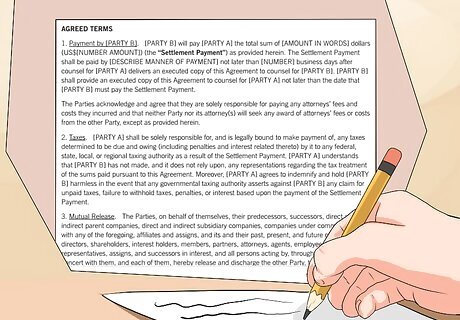
Sign your contract and begin performing. When you and the other party are satisfied with the document, you will both sign it and begin performance in the manner you both agreed upon.



















Comments
0 comment